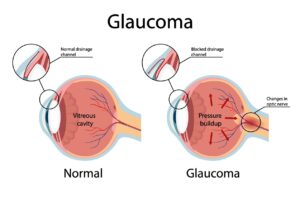Glaucoma is a complex and potentially sight-threatening condition that affects millions of people worldwide. It is crucial to understand the different types of glaucoma to ensure early detection and appropriate treatment. In this blog, we will explore the four main types of glaucoma: open-angle, closed-angle, and normal-tension, and congenital glaucoma and your treatment options.
What is Glaucoma?
Glaucoma is a group of eye diseases characterized by damage to the optic nerve, which is responsible for transmitting visual information from the eye to the brain. The most common cause of optic nerve damage in glaucoma is an increase in intraocular pressure (IOP). Normal or low IOP can also lead to optic nerve damage, as seen in normal-tension glaucoma.
Early detection of glaucoma is vital to prevent irreversible vision loss. Unfortunately, glaucoma is often asymptomatic in the early stages, earning it the nickname “the silent thief of sight.” Regular eye exams, including tests to measure IOP, are crucial for early detection and treatment initiation.
What are the Different Types of Glaucoma?
1. Open-Angle Glaucoma
Open-angle glaucoma is the most common type of glaucoma, accounting for approximately 90% of all cases. It occurs when the drainage angle of the eye becomes less efficient over time, leading to a gradual increase in IOP. This increase in pressure can cause progressive damage to the optic nerve.
Causes and Risk Factors
The exact cause of open-angle glaucoma is not fully understood. However, certain risk factors have been identified, including age, family history of glaucoma, ethnicity (African Americans are at higher risk), and certain medical conditions such as diabetes and hypertension.
Symptoms and Diagnosis
In the early stages, open-angle glaucoma is usually asymptomatic. As the disease progresses, patients may experience peripheral vision loss, tunnel vision, and difficulty adjusting to low-light conditions. Diagnosis is made through a comprehensive eye exam that includes measuring IOP, assessing the optic nerve, and conducting visual field tests.
Treatment Options
The primary goal of treatment for open-angle glaucoma is to lower the IOP to prevent further damage to the optic nerve. Treatment options include prescription eye drops, oral medications, laser therapy (such as selective laser trabeculoplasty), and surgery (such as trabeculectomy or glaucoma drainage devices).

2. Closed-Angle Glaucoma
Closed-angle glaucoma occurs when the drainage angle of the eye becomes completely blocked, preventing the outflow of aqueous humor, and causing a rapid increase in IOP. This type of glaucoma is considered a medical emergency and requires immediate attention to prevent permanent vision loss.
Causes and Risk Factors
Closed-angle glaucoma can be caused by a narrow drainage angle, which increases the risk of the iris blocking the drainage pathway. Certain factors, such as age, ethnicity (Asian and Inuit populations are at higher risk), and anatomical variations in the eye, can increase the likelihood of developing closed-angle glaucoma.
Symptoms and Diagnosis
Closed-angle glaucoma often presents sudden and severe symptoms, including eye pain, headache, blurred vision, halos around lights, and nausea. Diagnosis is made through a comprehensive eye exam, which may include measuring IOP, assessing the drainage angle, and examining the optic nerve.
Treatment Options
The primary treatment for closed-angle glaucoma is aimed at reducing IOP and relieving the blockage in the drainage pathway. This can be achieved through the use of oral medications, intravenous medications, laser peripheral iridotomy (creating a small hole in the iris), or, in severe cases, surgical intervention.
3. Normal-Tension Glaucoma
Normal-tension glaucoma, also known as low-tension glaucoma, is a type of glaucoma characterized by progressive optic nerve damage and visual field loss despite normal IOP levels. The exact cause of normal-tension glaucoma is still under investigation, but it is believed to be influenced by various factors, including vascular dysfunction and optic nerve vulnerability.
Causes and Risk Factors
The causes of normal-tension glaucoma are not fully understood. However, certain risk factors have been identified, including a family history of glaucoma, Japanese ethnicity, systemic vascular diseases, and certain anatomical characteristics of the optic nerve.
Symptoms and Diagnosis
Similar to other types of glaucoma, normal-tension glaucoma is often asymptomatic in the early stages. As the disease progresses, patients may experience visual field loss, difficulty with night vision, and, in advanced cases, reduced central vision. Diagnosis is made through comprehensive eye exams that include measuring IOP, assessing the optic nerve, and visual field tests.
Treatment Options
The treatment goal for normal-tension glaucoma is to prevent further damage to the optic nerve. This is achieved by lowering IOP through the use of prescription eye drops, oral medications, laser therapy (such as selective laser trabeculoplasty), or surgery (such as trabeculectomy or utilizing glaucoma drainage devices).
4. Congenital Glaucoma
Congenital glaucoma is a rare type of glaucoma that is present at birth or develops within the first year of life. It results from the abnormal development of the eye’s drainage system before birth, leading to increased intraocular pressure in infants and young children.
Causes and Risk Factors
The primary cause of congenital glaucoma is a developmental anomaly in the eye’s drainage system. While the exact reason for this malformation isn’t entirely clear, some factors may increase the risk. These can include inherited genetic mutations, family history of congenital glaucoma, and certain prenatal factors or conditions that affect fetal eye development.
Symptoms and Diagnosis
Congenital glaucoma often manifests with noticeable symptoms in infants. These can include excessive tearing, sensitivity to light (photophobia), an enlarged eye or cornea, or a cloudy cornea. Due to the overt nature of these signs, early diagnosis is possible. A comprehensive eye examination will include measurements of IOP, assessment of the drainage angle, and evaluation of the optic nerve’s health.
Treatment Options
The primary treatment for congenital glaucoma is surgical intervention. Surgical procedures like goniotomy or trabeculotomy are often employed to correct the drainage angle and reduce IOP. In some cases, further surgeries or medications might be required to maintain normal eye pressure. Regular follow-ups are crucial to monitor the child’s eye health and ensure that the treatment is effective.
Prevention and Lifestyle Tips
While the exact cause of glaucoma is not fully understood, certain strategies may help reduce the risk of developing the condition. These include maintaining a healthy lifestyle, managing underlying medical conditions (such as diabetes and hypertension), protecting the eyes from injury, and avoiding prolonged use of corticosteroids.
In addition to general preventive measures, certain lifestyle modifications may be beneficial for individuals with glaucoma. These include regular exercise, a balanced diet rich in antioxidants and omega-3 fatty acids, ceasing smoking, limiting caffeine intake, and practicing stress management techniques.
Importance of Regular Eye Exams
Scheduling regular eye exams is pivotal in the early detection and management of glaucoma. You can trust our team at Florida Eye for expert care with your eye exams. Our eye care professionals meticulously assess the health of your optic nerve and perform comprehensive tests to identify early signs of glaucoma. By choosing Florida Eye for your vision needs, you’re prioritizing early detection, and allowing for prompt intervention and the start of effective treatments. This timely action can be instrumental in halting or slowing down the progression of the disease.
Contact Us
Glaucoma is a serious eye condition that needs early attention to prevent vision issues. It’s important to understand the four major types: open-angle, closed-angle, normal-tension, and congenital glaucoma. Regular check-ups are key, and that’s where Florida Eye comes in. Our team is here to help you maintain good eye health. If you want to take proactive steps and get expert advice on managing glaucoma, don’t hesitate. Schedule a consultation with Florida Eye today and ensure your eyes get the best care possible.



